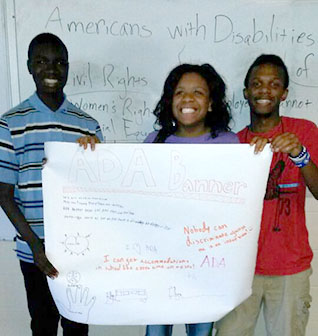The Independent Living Resource Center (ILRC)(in Jacksonville, Florida operates one of IEL’s career-focused Ready to Achieve Mentoring Programs (RAMP) for youth with disabilities. In honor of the 25th anniversary of the ADA, ILRC’s RAMP youth created an ADA banner. Before creating the banner, the youth discussed how the ADA has impacted various aspects of their lives from transportation to employment. To get the conversation started, the youth first thought about their everyday activities and then identified how the ADA has made those activities accessible to individuals with disabilities. Here is the recipe for organizing and implementing your own ADA Generation youth story session.
 Materials:
Materials:
- Markers
- Camera
- White Butcher Paper
- Construction Paper
- Dry erase markers and whiteboard
Procedure:
- Before the day of the workshop, call all the students ahead of time and let them know the topic of the workshop. Tell them to start thinking about a creative way they’d like to tell their disability story.
- At the workshop, before starting have students sign in and set their weekly goals.
- Begin the workshop with a discussion of the Americans with Disabilities Act. Tell students that the ADA was created in 1990 and was made to help people with disabilities in everyday life.
- Have a brainstorming session. Ask students “What some things are that people do in every day life?” These could be very small daily activities such as using the bathroom or traveling somewhere, or things you do for fun such as go to the park or movie theater, or daily duties such as work or school.
- Use student suggestions to point out how the ADA has helped people with disabilities. For example, if a student says “ride the bus” point out that a person with a physical disability may have difficulty riding the bus without any accommodations. Point out some accommodations that are required through the ADA.
- If you get stuck, here are some of the things the ADA does:
- Make it so an employer cannot discriminate against a person with a disability in regards to hiring, firing, or promoting them.
- All buildings must be accessible to persons with disabilities, such as having wheelchair ramps, elevators, and accessible bathrooms.
- City administration buildings have to be accessible.
- 911 lines must have equipment to respond to deaf callers.
- Newly purchased city buses must have wheelchair lifts.
- Bus drivers must call out stops for blind travelers.
- City recreation programs must allow disabled children and adults to participate equally.
- Schools must provide Individual Education Plans (IEPs) and 504 Plans for qualified students with disabilities if requested by the parent (this is technically under the IDEA, but for our purposes we can include it.)
- Express to students that this is a civil rights act, so that people with disabilities cannot be legally discriminated against. In the past, people with disabilities were not always welcome in every day life (such as, people with developmental disabilities might be not allowed in movie theaters just because people thought they were weird). The ADA has helped grant people with disabilities equality in the US.
- After the brainstorming session is over, ask students about how the ADA has affected their own lives, and how it may continue to affect their lives.
- Ask students to tell their “ADA story” in some way: it can be written, drawn, acted out, or expressed through poetry—anything, as long as it has to do with how the ADA has affected their lives. Students can even create an “ADA Banner” with the butcher paper, and it can be held up with a picture taken at the end of the class.